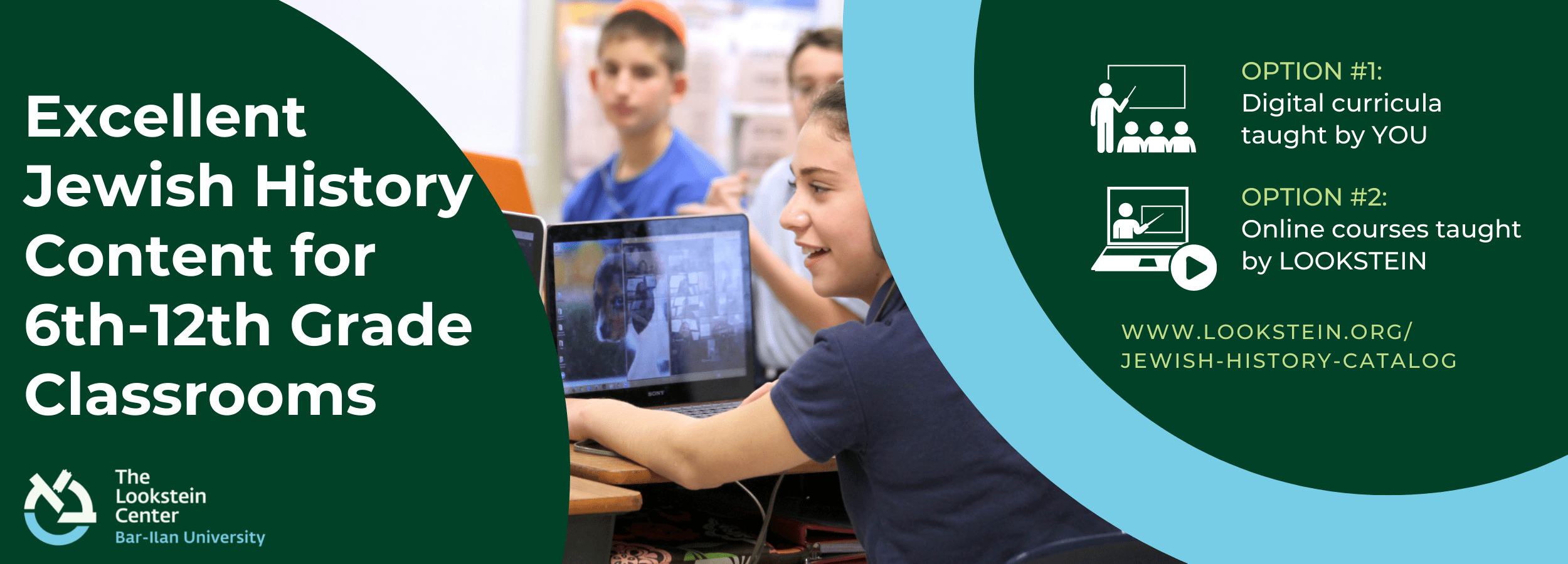A Framework for Evaluating Success in Jewish Education
Jewish education is one part of a broader complex of experience, learning, and growth that informs an individual’s understanding of him or herself in the world (Chazan, Chazan, and Jacobs). The question before us is: How does Jewish education contribute to the way a person interacts with the world?
Race, ethnicity, and nation are not entities in the world but ways of seeing the world. They are ways of understanding and identifying oneself, making sense of one’s problems and predicaments, identifying one’s interests, and orientating one’s actions. They are ways of recognizing, identifying, and classifying other people, of constructing sameness and difference, and of “coding” and making sense of their actions. They are templates for representing and organizing social knowledge, frames for articulating social comparisons and explanations, and filters that shape what is noticed and unnoticed, relevant or irrelevant, remembered or forgotten. (Brubaker)
In the spirit of this expansive understanding of Jewish education, this article suggests that in evaluating the work of Jewish educators, we adopt Bethamie Horowitz’s argument that Jewish education is about nurturing “Jewish consciousness.”
The challenge for the Jewish community is to create or foster vibrant, compelling, communities, institutions, experiences, and relationships that inspire interest, a sense of Jewish connection, belonging, and loyalty. It all comes down to consciousness (the opposite of indifference) and how to encourage that consciousness as much as possible. (Horowitz).
Jewish consciousness is holistic, informing doing, thinking, and feeling. “Meaning-making” is integral to Jewish consciousness, occurring as individuals interpret what is occurring in their lived-experience to understand how to act and the implications of their actions.
Success: Opting-Into Jewish Consciousness
Successful educational experiences expand and deepen participants’ Jewish consciousness. From an evaluation perspective, we ask: Do participants in educational programs opt-in and embrace the elements of Jewish consciousness promoted by their educators? To what extent and depth does the educational experience contribute to the participant adopting Jewish ways of interacting with the world?
The precise formulation of the above questions depends on the manner participants in an educational program interact in Jewish ways with the world. Do the Jewish skills and knowledge taught become relevant to the participants’ lives? We answer this question by delineating six dimensions of Jewish consciousness. The educational mission and corresponding evaluation questions change according to the Jewish consciousness dimensions an educator is addressing.
Six Dimensions of Jewish Consciousness
1. Establishing Relevance
As a result of an educational experience, do participants move from apathy to caring? Will we hear them state regarding the educational experience: “I am a Jew and that matters for my life?” If relevance is not established, nothing else matters, as knowledge and skills learned will simply be disregarded once the educational process ends. If relevance is established, how did the educational experience trigger the cognitive and emotional shift?
2. Provoking Curiosity
Once relevance is established, do participants express curiosity to learn more? Has the educational program succeeded in promoting a desire among participants to explore the implications of the subject matter for their lives?
3. Making Jewish Normal
Once curious, participants need pathways through which they can continue to acquire Jewish knowledge, seeking out social and intellectual relationships with other Jews as a normal and ongoing part of their lives. Effective educators provide those pathways as well as the knowledge and skills for starting along the way. When successful, participants opt-in and continue to make Jewish life experiences a normal part of their lives.
4. Encouraging Leadership
Once being Jewish is a normal part of one’s life, a person might embrace leadership by providing opportunities for others to have similar consciousness expanding experiences. Among many different leadership opportunities educators provide, we can include a teen’s choice to become a counselor at his or her summer camp, a college student’s decision to join the board of a college Hillel or Chabad, or an adult’s opting to pursue a degree in Jewish education, professional studies, or the clergy. Leadership might also involve micro-activities that are part of family and community life that require knowledge and skills, such as taking leadership roles in the prayer service, leading a Passover Seder, or initiating a Jewishly informed itinerary for one’s family vacation.
5. Becoming a Master
At the apex of the opting-in process are those whose depth of dedication, commitment, and knowledge enables them to become masters in a particular area of Jewish civilization (Kaplan). A master is not only able to teach others, but also adapts Jewish civilization to contemporary times, enabling Jewish knowledge and lifeways to become relevant to a new generation living in a particular time and place.
6. Nurturing Peoplehood Consciousness
“Peoplehood Consciousness” (Ravid) ideally informs the other five dimensions. The often-unstated assumption girding the work of Jewish educators is that we are part of a global Jewish people. The goal is for Jews to feel part of and committed to the historical and contemporary global Jewish experience. Yet, that goal is often not explicitly planned for and thus is not an intentional outcome of Jewish education. Enabling individuals to pursue their personal Jewish journeys, deepening their Jewish skills and knowledge along the way, does not necessary mean that they will embrace Jewish Peoplehood.
The following are examples of possible Peoplehood questions that Jewish educators can choose to make explicit in their work. Should Jews feel a commitment and responsibility to supporting one another? Is the welfare of Jews who live elsewhere a concern? Should the lessons of Jewish history inform the way Jews think about the world today? Is it necessary to support communal organizations such as a Federation or Jewish home for the elderly? Is the relationship of Jews living outside of Israel to Israel a priority, even if one might disagree with the policies of an Israeli government? Is Tikkun Olam a Jewish collective responsibility, and if so, how does the fact that we are part of a People enable us to do Tikkun Olam more effectively?

Ezra Kopelowitz
Dr. Ezra Kopelowitz is the CEO of Research Success Technologies, a company that specializes in research and evaluation for Jewish organizations, and has published widely in areas that touch on Jewish identity, education, and peoplehood. Ezra is a member of the faculty of the Spertus Institute for Jewish Leadership and serves as a Research Fellow at the Center for Jewish Peoplehood Education.
See all the previous issues of Jewish Educational Leadership
It is important to note that Jewish educators will likely find participants in their educational programs on different dimensions of Jewish consciousness at any given time. For example, a Rabbi teaching an introduction to Judaism class might have a student who has dedicated him or herself to the study and teaching of Jewish history, seeing the lessons of history as essential for understanding the world around us. However, the same person might not have seen much relevance for the role of Jewish religious ritual, ceremony, and law in his or her life. Hence, the Professor of Jewish history becomes a student in the initial stages of opting-in to a Jewish religious education.
Evaluation: The Case of Israel Education
In assessing the contribution of education to consciousness expansion there are at least three interrelated evaluation dimensions: individual outcomes, educational inputs, and the educational environment.
1. Individual Outcomes
Individual outcomes involve changes in doing, thinking, and feeling resulting from an educational experience that contributes to an expansion of Jewish consciousness. Using Israel education as a case study, the following table provides examples of possible individual level outcomes at each stage of the consciousness building process.
Dimensions of Jewish Consciousness |
Examples of Individual Outcomes: Israel Education Case Study |
| 1. Relevant |
From indifference to the realization that “because I am Jewish, Israel is a special country for me.” |
| 2. Curious |
The desire to learn more about Israel, whether to learn Hebrew, learn about biblical or modern Israeli history, pursue connections with Israelis, learn popular Israel songs, take a Krav Maga course, learn about Israeli politics, etc. |
| 2. Normal |
Finding it meaningful to follow Israeli news on a regular basis, seeking out discussions about Israel with others, learning and speaking Hebrew, maintaining collegial or social relationships with Israelis, etc. |
| 3. Leader |
Seeing as valuable and encouraging others to engage with Israel through education, Israel advocacy, deepening the presence of Israel in one's organization, etc. |
| 4. Master |
Committed and inspired to the point of becoming a master Israel educator. Working to devise educational and community building strategies and Israel-Diaspora partnerships that adapt and deepen the connection of Jews living inside and outside of Israel to one another (Kopelowitz). |
| 5. Peoplehood |
Committed to promoting the welfare of Jews living in Israel and the state of Israel, and the responsibility of Israel and Israelis to the Jewish People. |
2. Educational Inputs
To what extent are the individual level outcomes described above the result of an intentionally designed educational process? Jeff Kress provides a useful framework, which can be applied to understanding how educators nurture Jewish consciousness. He argues that participants in educational experiences should be placed in novel situations, that they process through dialogue with their teachers and peers, with adequate opportunities for reflection. When successful, the cognitive schemas participants utilize to understand their worlds are challenged and expand to include Jewish reference points.
Staying with Israel education, an excellent example of Kress’ framework at work occurs in Mifgashim—organized educational encounters involving Israeli-Jews and Jews who live elsewhere. When done well, the mifgash challenges the cognitive schemas of all the participants. The mifgash might involve traveling, service work, and/or learning together. The common element is that when they are together participants engage in reflective conversations in which they need to explicate who they are as Jews, the similarities and differences between them, and the implications for some aspect of their lives. For many, the mifgash is the first time that they need to actively think about who they are Jewishly, their connection to and responsibility for other Jews, and reflect on the resulting realizations.
3. Educational Environments That Support Jewish Consciousness
Successful Jewish education almost always occurs within educational environments in which the professional staff are aware of the larger consciousness-raising goals of their organization and coordinate with one another to implement them. The result is the creation of educational experiences that might range over many years, which occur in multiple contexts and reinforce each other over time. Thus, for example, Israel education at a synagogue school can provide many instances in which Israel serves as a reference point for the developing Jewish consciousness of a child coming of age from kindergarten through high school. These reference points occur through participation in ceremonies and celebrations, singing Israeli songs, learning in formal classes, participating in educational trips to Israel, interacting with counselors and teachers who are Israelis, and developing friendships with Israelis through twinning programs. At the most outstanding synagogue schools, many of these educational experiences reference common educational values and themes that further sharpen and deepen a young person’s expansion of Jewish consciousness.
In conclusion, this paper places the issue of meaning-making in Jewish education within the broader conceptual frame of Jewish Consciousness. What it means to be Jewish and the role of Jewish education unfolds along six distinct dimensions of Jewish consciousness. Each dimension offers different challenges and demands distinct educational strategies and measures for determining success.



